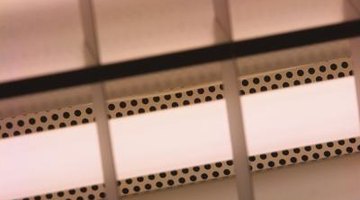My Fluorescent Kitchen Light Doesn't Work in High Humidity
Fluorescent lights are an alternative to incandescent lights, providing more hours of illumination with less energy cost. Typically, the initial cost of buying a fluorescent bulb is greater than that of an incandescent one. To ensure that you gain back the savings of your long-lasting fluorescent bulb, check that you purchase a model that is designed to work in humid areas, such as kitchens. If your fluorescent light still doesn't work properly, a second round of troubleshooting will usually identify any humidity-related problems.
Understanding Fluorescent Lights

Unlike an incandescent light, your fluorescent lamp relies on the movement of electrical current through gas. Because this gas fills the entire tube or bulb of the fluorescent lamp, the glass material itself also forms part of the conductive material. By contrast, an incandescent lamp passes electrical charge through metal and the glass bulb is immaterial. Because the humidity level of the air outside the fluorescent light directly affects the glass, it also affects the light's conductivity and performance.
Effects of Humidity on Fluorescent Lights
When the humidity level of the surrounding air exceeds 65 percent, the electrostatic charge along the outside of the fluorescent lamp's glass tube or bulb begins to change. With the shift in electrostatic charge, the current flowing through the lamp loses electrons to the external electrostatic charge, interrupting the lamp's ability to illuminate. As a result, if you are looking to light a space where the humidity regularly surpasses 65 percent, such as a poorly ventilated kitchen, standard fluorescent lamps may not suffice.
Fluorescent Lighting for Humid Places
While humidity can negatively impact some fluorescent lights, it's still possible to use them in humid areas, such as kitchens, as well as greenhouses, bathrooms or outdoor areas. Opt for lights with silicon coatings, which keep the humidity from affecting the tube's electrostatic charge. Some compact fluorescent lightbulbs (CFLs) are marked as weatherproof.
Additional Considerations
Even if you use a weatherproof fluorescent light with a silicon coating, certain conditions may still cause humidity to interfere with its proper functioning. Keep the tube or bulb clean from dust, which can reverse the benefits of the silicon surface. One solution is to house any fluorescent lights in closed light fixtures. If the tube or bulb of the light is located too close to its metal housing, the lack of space can also interfere with proper functioning. Just as humidity can draw electrons to the surface of the tube, metal elements can conduct excessive amounts of electrons, compromising the lamp's performance. High humidity can shorten the life of CFLs. Running the bathroom fan or opening a window can mitigate this problem.
References
Writer Bio
Danielle Hill has been writing, editing and translating since 2005. She has contributed to "Globe Pequot" Barcelona travel guide, "Gulfshore Business Magazine," "Connecting Lines: New Poetry from Mexico" and "The Barcelona Review." She has trained in neuro-linguistic programming and holds a Bachelor of Arts in comparative literature and literary translation from Brown University.
Photo Credits
- Hemera Technologies/AbleStock.com/Getty Images
More Articles



